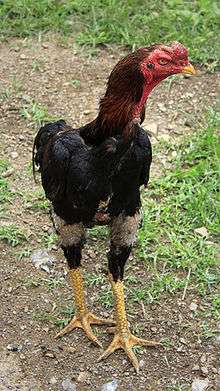Shamo chickens

Shamo (軍鶏) is an overall designation for gamefowl in Japan. There are seven recognised breeds of Shamo chicken in Japan, all of which are designated Natural Monuments of Japan. The Shamo breeds are thought to derive from fighting chickens of Malay type brought from Thailand in the early part of the seventeenth century.[1]:13
History
The name "Shamo" was a corruption of the word "Siam", which means "Thailand", during the early Edo period. Even though the breed was originally from Thailand, it has been selectively bred for several hundred years and is very different from the original stock. The breed is used in naked-heeled cockfighting in Japan, where it is still legal. It is also bred all over the world for its show quality and unique upright posture.
O-Shamo and Chu-Shamo are designations for different weight categories of large fowl, whereas the Nankin-Shamo is a bantam chicken. The Ko Shamo (シャモ), unlike O-Shamo and Chu-Shamo, is merely an ornamental breed not used for cockfighting, although it is bred to be temperamental and show the spirit of a fighter. While it is not related to the other breeds, it is often assumed to be because of the similarity of their names.
Breeds
The seven recognised Shamo breeds designated as Natural Monuments of Japan are:[1]:13[2]:92
- Ehigo-Nankin-Shamo
- O-Shamo (large Shamo, 大軍鶏)
- Kinpa
- Ko-Shamo (small Shamo, 小軍鶏)
- Nankin-Shamo (Nankin Shamo, 南京軍鶏)
- Yakido or Ygido (八木戸鶏)
- Yamato-Shamo or Yamato Gunkei
Other Shamo variants are the Chu-Shamo (medium Shamo, 中軍鶏)[3]:321 and the Chibi Shamo.[3]:322
Shamo in the West
In the United Kingdom, the Shamo, Ko-Shamo, Nankin Shamo, Yakido and Yamato Gunkei are recognised as distinct breeds,[4] while Chu-Shamo and Chibi Shamo receive a passing mention in the British Poultry Standards.[3]:321–322 The Entente Européenne recognises the Shamo, Ko-Shamo, Yakido and Yamato Gunkei, and lists the Chu-Shamo and Nankin Shamo as unrecognised.[5] The Australian Poultry Standards have only one form of Shamo, which has a minimum weight of 3 kg.[6] The American Poultry Association recognises the Shamo as a breed, both full-sized and bantam.[7]
References
- 1 2 Sayed Abdel-Maksoud Osman, Masashi Sekino, Takehito Kuwayama, Keiji Kinoshita, Masahide Nishibori, Yoshio Yamamoto, and Masaoki Tsudzuki (2006). Genetic variability and relationships of native Japanese chickens based on microsatellite DNA polymorphisms-Focusing on the natural monuments of Japan. The Journal of Poultry Science 43' (1): 12–22.
- ↑ Masaoki Tsudzuki (2003). Japanese native chickens. In: Hsiu-Luan Chang, Yu-chia Huang (editors) (2003). The Relationship between Indigenous Animals and Humans in APEC Region. Taipei: Chinese Society of Animal Science. Pages 91-116.
- 1 2 3 Victoria Roberts (2008). British poultry standards: complete specifications and judging points of all standardized breeds and varieties of poultry as compiled by the specialist breed clubs and recognised by the Poultry Club of Great Britain. Oxford: Blackwell. ISBN 9781405156424.
- ↑ Breed Classification. Poultry Club of Great Britain. Accessed August 2017.
- ↑ Liste des races et variétés homologuée dans les pays EE (28.04.2013). Entente Européenne d’Aviculture et de Cuniculture. Archived 16 June 2013.
- ↑ Limited, Victorian Poultry Fanciers Association (2011). Australian poultry standards (2nd ed.). Ballarat, Vic.: Victorian Poultry Fanciers Association Limited. pp. 22–227. ISBN 9781921488238.
- ↑ APA Recognized Breeds and Varieties: As of January 1, 2012. American Poultry Association. Archived 4 November 2017.